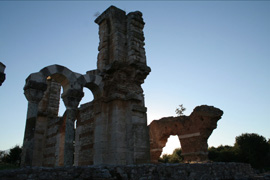

|
After the foundation of Constantinople in 324 AD, the city of Philippi recovered its Greek character within the context of the Eastern Roman Empire. Until the 6th century (in the reign of Justinian), it goes through a period of prosperity, which is demonstrated for example by the construction of several large churches.
Around 620 AD, Philippi suffered extensive earthquake damage. Life continued, but the city had lost its former glory and shrank to the foot of the Acropolis hill. In those same years, large parts of Greece were plagued by raids from Slavic groups. As a result, many of the Greek provinces of the Byzantine Empire suffered.
In the 9th century, Philippi was occupied by the Bulgarians, but the Byzantines soon recovered it and it began to regroup. The city walls were restored and the Acropolis reinforced with a new fortification in the mid-10th century. Two centuries later, the Arab geographer Idrisi described Philippi as an important commercial centre with rich agricultural production. The tower on top of the Dikili Tash mound probably dates from this period. It was destroyed in the 13th or 14th century, a period of further instability and decline.
We do not know exactly when the city was finally abandoned. At the end of the 14th century (1387) the city followed the fate of the Byzantine Empire and was subjugated by the Ottomans; less than a century later, Philippi seems to have been deserted, as witnessed by Cyriacus of Ancona.
|